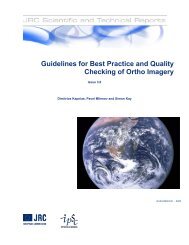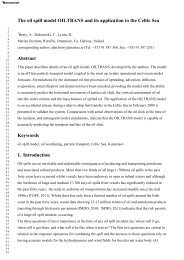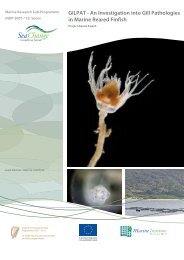Marine Industries Global Market Analysis - Marine Institute
Marine Industries Global Market Analysis - Marine Institute
Marine Industries Global Market Analysis - Marine Institute
Create successful ePaper yourself
Turn your PDF publications into a flip-book with our unique Google optimized e-Paper software.
MARINE INDUSTRIES GLOBAL MARKET ANALYSIS<br />
121<br />
24 Education & Training<br />
1999–03 2004 2005–09<br />
Irish <strong>Market</strong> €M – – –<br />
UK <strong>Market</strong> €M – – –<br />
Europe <strong>Market</strong> €M – – –<br />
World <strong>Market</strong> €M 10,041 1,537 7,691<br />
Definition – fees from higher education in marine subjects and training of marine personnel.<br />
24.1 INTRODUCTION<br />
Education & Training has three primary activities: seafarer training, offshore worker<br />
training and higher education (e.g. universities).<br />
Seafarer training – 400,000 officers and 825,000 ratings are employed worldwide<br />
with 60% of the latter being from the Asia Pacific region.There has been a 27% oversupply<br />
of ratings although there are doubts about the extent to which large numbers<br />
of these ratings are qualified for international service. 81<br />
The majority of ratings are recruited from developing countries, especially the Far<br />
East.The Philippines alone provides almost 20% of the global maritime workforce.<br />
The Philippines is the largest supplier of seafarers with some 180,000 or 28.5% of the<br />
total maritime population of 632,000 on board vessels worldwide. Russia is second<br />
with 7.3%.<br />
Currently, 418 ‘maritime schools’ are listed worldwide. In 2000, there were 121<br />
maritime schools in the Philippines rapidly resulting in an over-supply of trained<br />
seafarers. However, in 2004 the number of schools was down to 76, twenty of which<br />
will be phased-out in the next two years, after their last students have graduated.<br />
Of the 500,000 registered Filipino seafarers, enough to man most of the vessels afloat<br />
around the world, more than 300,000 are unemployed.<br />
However, other countries are also adding training capacity – South Africa opened<br />
a 150 student training academy in 2003 offering two three-year courses.<br />
Amongst training now being used are tools such as bridge and engine room<br />
simulators. Specialised courses for the fishing industry are offered by some<br />
establishments. In 2003, 1,681 attendances were registered in Ireland at the country’s<br />
BIM Training Centres.<br />
China and India are also significant maritime labour supply nations. Other major<br />
labour supply countries include Greece, Japan, Norway, Russia and the UK.<br />
There is regarded to be a 4% undersupply of officers which is expected to rise to<br />
12% by 2010.The OECD countries remain the most important source for officers,<br />
but growing numbers of officers are now recruited from the Far East and Eastern<br />
Europe and it is expected that this trend will accelerate as the ageing OECD officer<br />
group retires.<br />
Note:As training may be provided in one<br />
country to meet demand from other<br />
countries, it is difficult to segment the<br />
‘market’ by regions.This is particularly the<br />
case for the shipping industry and to a lesser<br />
extent higher education.<br />
81<br />
http://www.marisec.org/resources/2000Manpowerupdate .htm

















